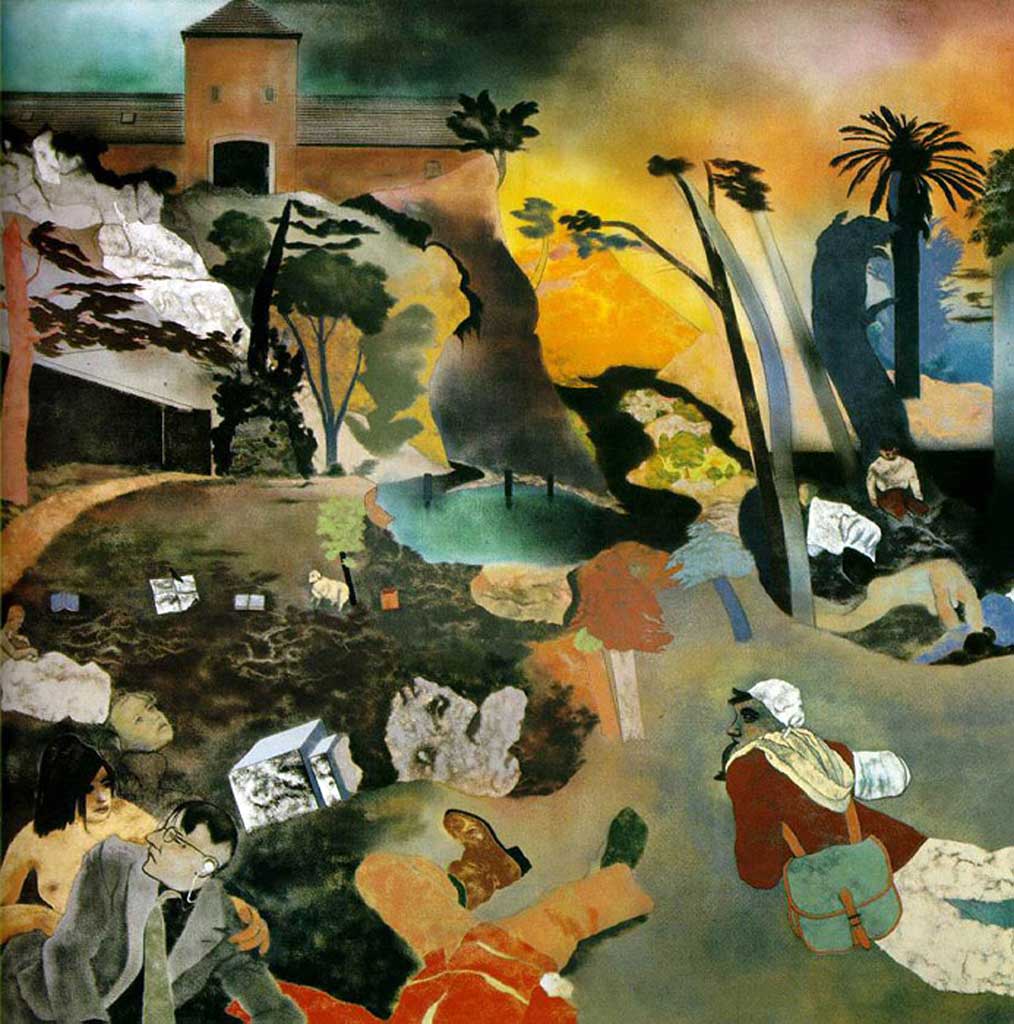Great Works: If Not, Not, 1975-6 (152.4cm x 152.4cm), R B Kitaj
Scottish National Gallery of Modern Art, Edinburgh

This painting, made by an American painter who spent much of his life in London, wrestling with the nature of his European influences (Cézanne, Degas, Kafka, for example), and striving to reconcile those influences with his own conflicted Jewish-American identity, is both lovely and unlovely, a seductive visual object and one that is replete with much troubling and morally uncertain subject matter. At first glance, it looks almost paradisal – look at that palm tree against the flush of an orange sky. But in its details, it is often dystopian – is that orange not a fumy and soon-to-be-choking rage of smoke or flame, rather than the untroubled colour of the rising or setting sun?
The unpleasing, unbreachable, inescapable blankness of the gatehouse at Auschwitz (top left) seems to preside over its atmosphere. From there, our eye tumbles pell-mell downhill, passing by a pool of still (stagnant?) water, a floating bust of Matisse, young men who look slumped (sick unto death), a likeness of a bespectacled T S Eliot cradled by a young woman who owes at least some of her visual identity to Gauguin, and much else from painting or poetry that we feel that we half-recognize. One figure seems to be reclining, while another (the one whose upper half is cut off by the bottom edge of the painting) may be dead. What is the difference between the posture of a man who reclines from that of one who is dead? Troublingly similar could be one answer. They are all bits and pieces, disjecta membra, like Eliot's "Waste Land" itself, fragments shored against our ruin.
As our eye moves across and around, we seem to be experiencing landscape in its making and unmaking (yes, this is certainly not a settled, unbudgeable, dependable terrain). In part at least, it seems to consist of a half-remembered evocation of Giorgione's La Tempesta, but it is a topsy-turvy kind of ground that seems to buck and to lurch, to come and to go even as we look at it, writhing and heaving and turning like a sick man on his bed. We could also call it a patchwork of landscapes, layered over or butting up against one another like torn fragments of cloth. It also feels like a weightless landscape, ever shifting, a cloth being shaken out in the wind.
As often with Kitaj, the colours are shrill, brilliant, seductive, but they are also eerie. Is there not a whiff of napalm or Agent Orange in the air? After all, this painting was made as the Vietnam War was drawing to a close. The entire endeavour, which is a kind of wild assemblage of disparate parts, seems to be akin to a rough-and-ready visual summary of so much that has been written and said about the predicament of man in the West in 20th century: that as a result of that century's terrible collective calamities (the destructive power of global warfare, for example, the moral blight of Adolf Hitler), a psychic fissuring seemed to take place. For writers and artists, those antennae of the race as Ezra Pound once wrote, things fell apart. There was no centralising God any more, no dependable belief system, to hold it all together. "The centre cannot hold/ Mere anarchy is loosed upon the world" as the great W B Yeats declaimed in a great poem published in 1921. The human centre did not hold in that century. And it certainly did not hold for art. New irrationalisms, new wildnesses took a grip on artists as never before – think of Dada or of Surrealism, for example. Only the extreme would do to express the extremities of the baleful human condition.
Although Ron Kitaj would not have described himself as a Surrealist, this painting, made in 1975-6, seems to be completely and utterly post-Surrealist in its atmosphere. There is a relentless dream-wash of imagery here, from side to side and top to bottom, which itself resembles the movement of water... Nothing feels rules-governed across the length and the breadth of this picture plane. Nothing, we feel, has come into being as a result of particular decisions or calculations made by the conscious mind. There are two forces at work here, in contention with each other, the conscious and the subconscious mind, and the subconscious mind has the upper hand. Everything is welling up from the depths. The end of the making process must have been more an act of abandonment than one of completion. The quest could not go any the further. For what though? For a way of using paint in order to give some kind of coherence to a vision which consists of floating, disparate fragments – rather in the way that T S Eliot's "The Waste Land" consisted of floating, disparate fragments forever seeking coherence of a particularly fragmentary kind.
ABOUT THE ARTIST
R B Kitaj was born Ronald Brooks in Cleveland, Ohio, in 1932. He died in 2007. His paintings are often a complicated tissue of visual and literary references from many periods. The issue of his Jewish identity took on increasing importance to him as he aged.
Subscribe to Independent Premium to bookmark this article
Want to bookmark your favourite articles and stories to read or reference later? Start your Independent Premium subscription today.

Join our commenting forum
Join thought-provoking conversations, follow other Independent readers and see their replies